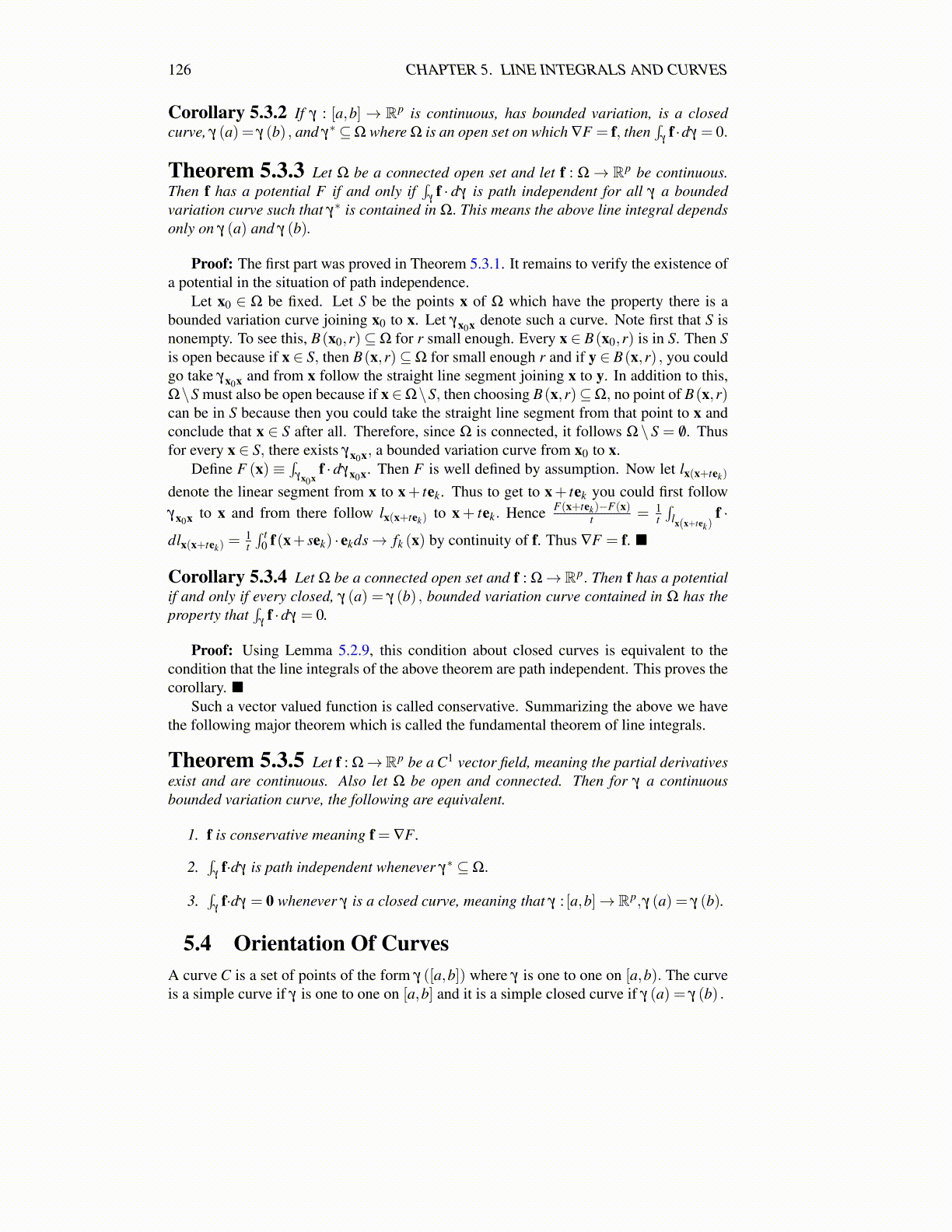
126 CHAPTER 5. LINE INTEGRALS AND CURVES
Corollary 5.3.2 If γ : [a,b]→ Rp is continuous, has bounded variation, is a closedcurve, γ (a) = γ (b) , and γ∗ ⊆Ω where Ω is an open set on which ∇F = f, then
∫γ
f ·dγ = 0.
Theorem 5.3.3 Let Ω be a connected open set and let f : Ω→ Rp be continuous.Then f has a potential F if and only if
∫γ
f · dγ is path independent for all γ a boundedvariation curve such that γ∗ is contained in Ω. This means the above line integral dependsonly on γ (a) and γ (b).
Proof: The first part was proved in Theorem 5.3.1. It remains to verify the existence ofa potential in the situation of path independence.
Let x0 ∈ Ω be fixed. Let S be the points x of Ω which have the property there is abounded variation curve joining x0 to x. Let γx0x denote such a curve. Note first that S isnonempty. To see this, B(x0,r)⊆Ω for r small enough. Every x ∈ B(x0,r) is in S. Then Sis open because if x ∈ S, then B(x,r)⊆Ω for small enough r and if y ∈ B(x,r) , you couldgo take γx0x and from x follow the straight line segment joining x to y. In addition to this,Ω\S must also be open because if x∈Ω\S, then choosing B(x,r)⊆Ω, no point of B(x,r)can be in S because then you could take the straight line segment from that point to x andconclude that x ∈ S after all. Therefore, since Ω is connected, it follows Ω \ S = /0. Thusfor every x ∈ S, there exists γx0x, a bounded variation curve from x0 to x.
Define F (x) ≡∫
γx0xf · dγx0x. Then F is well defined by assumption. Now let lx(x+tek)
denote the linear segment from x to x+ tek. Thus to get to x+ tek you could first followγx0x to x and from there follow lx(x+tek) to x + tek. Hence F(x+tek)−F(x)
t = 1t∫
lx(x+tek)f ·
dlx(x+tek) =1t∫ t
0 f(x+ sek) · ekds→ fk (x) by continuity of f. Thus ∇F = f. ■
Corollary 5.3.4 Let Ω be a connected open set and f : Ω→ Rp. Then f has a potentialif and only if every closed, γ (a) = γ (b) , bounded variation curve contained in Ω has theproperty that
∫γ
f ·dγ = 0.
Proof: Using Lemma 5.2.9, this condition about closed curves is equivalent to thecondition that the line integrals of the above theorem are path independent. This proves thecorollary. ■
Such a vector valued function is called conservative. Summarizing the above we havethe following major theorem which is called the fundamental theorem of line integrals.
Theorem 5.3.5 Let f : Ω→Rp be a C1 vector field, meaning the partial derivativesexist and are continuous. Also let Ω be open and connected. Then for γ a continuousbounded variation curve, the following are equivalent.
1. f is conservative meaning f = ∇F.
2.∫
γf·dγ is path independent whenever γ∗ ⊆Ω.
3.∫
γf·dγ = 0 whenever γ is a closed curve, meaning that γ : [a,b]→ Rp,γ (a) = γ (b).
5.4 Orientation Of CurvesA curve C is a set of points of the form γ ([a,b]) where γ is one to one on [a,b). The curveis a simple curve if γ is one to one on [a,b] and it is a simple closed curve if γ (a) = γ (b) .